Macroeconomic Assignment: Singapore's Economic Evolution
VerifiedAdded on 2021/06/17
|14
|2796
|364
Report
AI Summary
This report provides a comprehensive macroeconomic analysis of Singapore's economic performance over the past two decades. It examines key indicators such as GDP growth, inflation rates, and unemployment levels, providing insights into the trends and dynamics of each. The report delves into the factors influencing Singapore's GDP growth, including its open economy model, FDI inflows, and labor market dynamics. It also explores the reasons behind fluctuations in inflation, such as changes in the cost of living and labor market mechanisms. Furthermore, the report analyzes the unemployment trends, highlighting the impact of industrial and commercial development. The analysis includes relevant figures and data from 1997 to 2018. Finally, the report offers policy recommendations to improve the country's macroeconomic environment and concludes with a summary of the key findings and their implications for Singapore's economic future. The report is contributed by a student and is available on Desklib, a platform providing AI-based study tools.
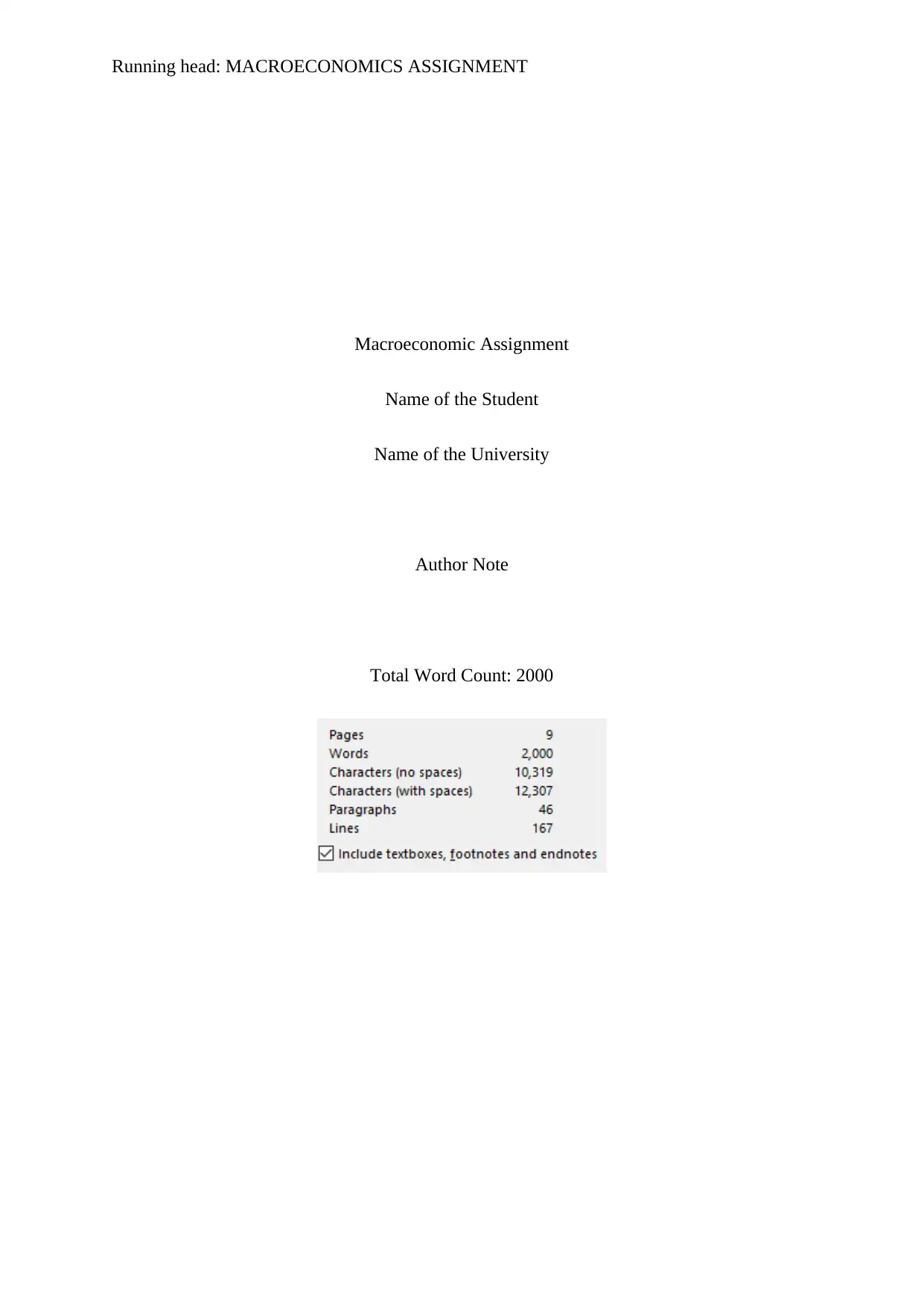
Running head: MACROECONOMICS ASSIGNMENT
Macroeconomic Assignment
Name of the Student
Name of the University
Author Note
Total Word Count: 2000
Macroeconomic Assignment
Name of the Student
Name of the University
Author Note
Total Word Count: 2000
Paraphrase This Document
Need a fresh take? Get an instant paraphrase of this document with our AI Paraphraser
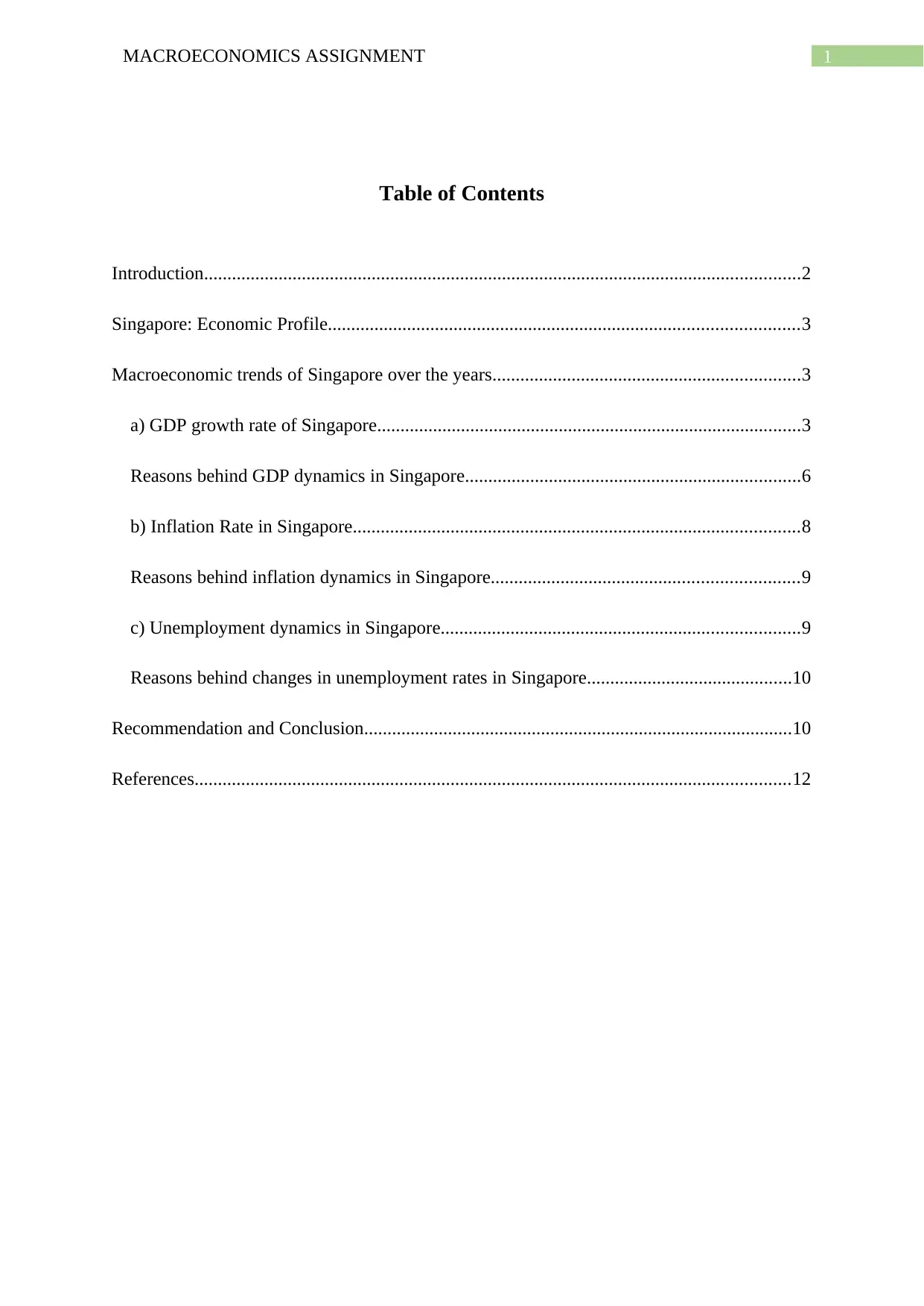
1MACROECONOMICS ASSIGNMENT
Table of Contents
Introduction................................................................................................................................2
Singapore: Economic Profile.....................................................................................................3
Macroeconomic trends of Singapore over the years..................................................................3
a) GDP growth rate of Singapore...........................................................................................3
Reasons behind GDP dynamics in Singapore........................................................................6
b) Inflation Rate in Singapore................................................................................................8
Reasons behind inflation dynamics in Singapore..................................................................9
c) Unemployment dynamics in Singapore.............................................................................9
Reasons behind changes in unemployment rates in Singapore............................................10
Recommendation and Conclusion............................................................................................10
References................................................................................................................................12
Table of Contents
Introduction................................................................................................................................2
Singapore: Economic Profile.....................................................................................................3
Macroeconomic trends of Singapore over the years..................................................................3
a) GDP growth rate of Singapore...........................................................................................3
Reasons behind GDP dynamics in Singapore........................................................................6
b) Inflation Rate in Singapore................................................................................................8
Reasons behind inflation dynamics in Singapore..................................................................9
c) Unemployment dynamics in Singapore.............................................................................9
Reasons behind changes in unemployment rates in Singapore............................................10
Recommendation and Conclusion............................................................................................10
References................................................................................................................................12
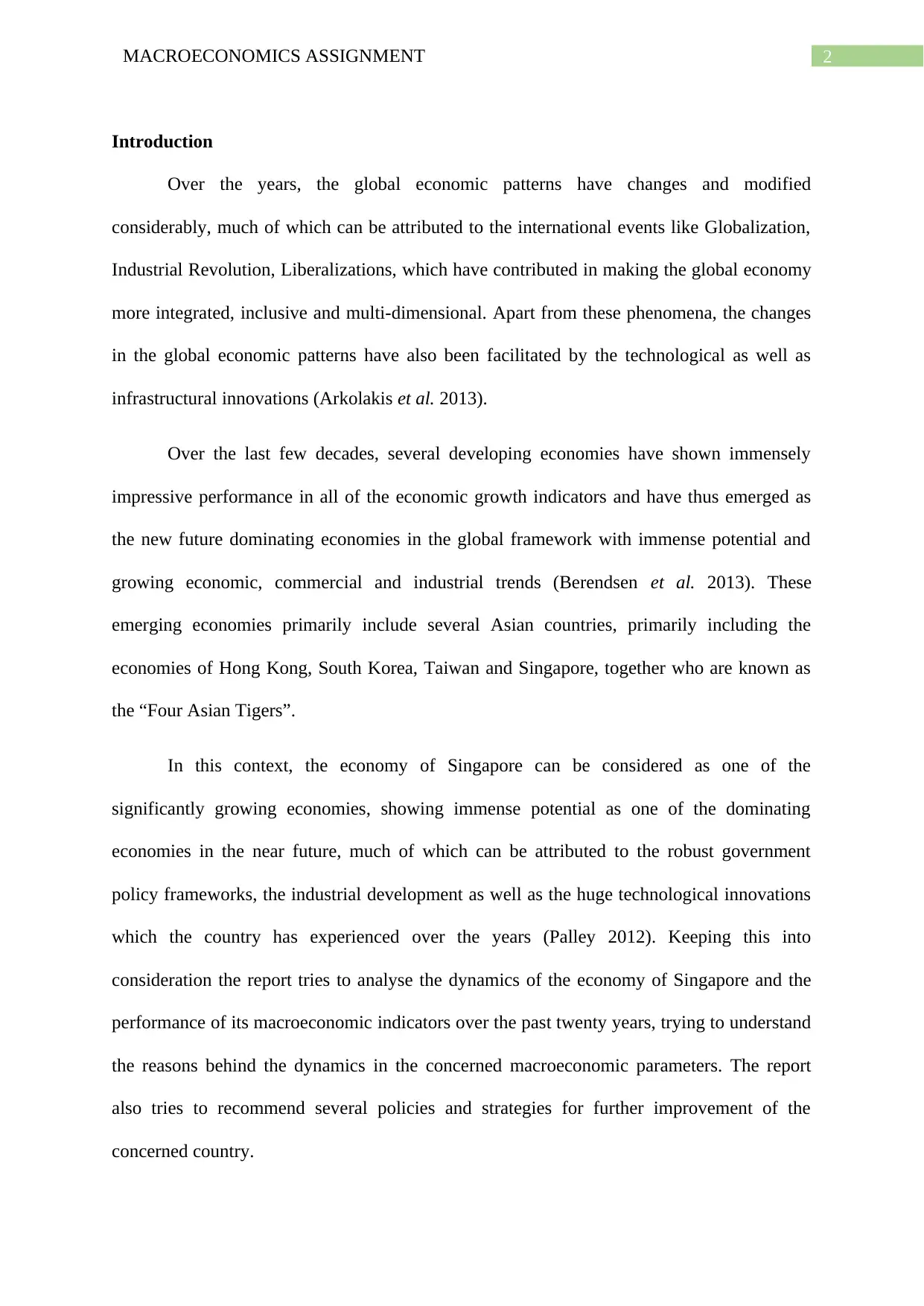
2MACROECONOMICS ASSIGNMENT
Introduction
Over the years, the global economic patterns have changes and modified
considerably, much of which can be attributed to the international events like Globalization,
Industrial Revolution, Liberalizations, which have contributed in making the global economy
more integrated, inclusive and multi-dimensional. Apart from these phenomena, the changes
in the global economic patterns have also been facilitated by the technological as well as
infrastructural innovations (Arkolakis et al. 2013).
Over the last few decades, several developing economies have shown immensely
impressive performance in all of the economic growth indicators and have thus emerged as
the new future dominating economies in the global framework with immense potential and
growing economic, commercial and industrial trends (Berendsen et al. 2013). These
emerging economies primarily include several Asian countries, primarily including the
economies of Hong Kong, South Korea, Taiwan and Singapore, together who are known as
the “Four Asian Tigers”.
In this context, the economy of Singapore can be considered as one of the
significantly growing economies, showing immense potential as one of the dominating
economies in the near future, much of which can be attributed to the robust government
policy frameworks, the industrial development as well as the huge technological innovations
which the country has experienced over the years (Palley 2012). Keeping this into
consideration the report tries to analyse the dynamics of the economy of Singapore and the
performance of its macroeconomic indicators over the past twenty years, trying to understand
the reasons behind the dynamics in the concerned macroeconomic parameters. The report
also tries to recommend several policies and strategies for further improvement of the
concerned country.
Introduction
Over the years, the global economic patterns have changes and modified
considerably, much of which can be attributed to the international events like Globalization,
Industrial Revolution, Liberalizations, which have contributed in making the global economy
more integrated, inclusive and multi-dimensional. Apart from these phenomena, the changes
in the global economic patterns have also been facilitated by the technological as well as
infrastructural innovations (Arkolakis et al. 2013).
Over the last few decades, several developing economies have shown immensely
impressive performance in all of the economic growth indicators and have thus emerged as
the new future dominating economies in the global framework with immense potential and
growing economic, commercial and industrial trends (Berendsen et al. 2013). These
emerging economies primarily include several Asian countries, primarily including the
economies of Hong Kong, South Korea, Taiwan and Singapore, together who are known as
the “Four Asian Tigers”.
In this context, the economy of Singapore can be considered as one of the
significantly growing economies, showing immense potential as one of the dominating
economies in the near future, much of which can be attributed to the robust government
policy frameworks, the industrial development as well as the huge technological innovations
which the country has experienced over the years (Palley 2012). Keeping this into
consideration the report tries to analyse the dynamics of the economy of Singapore and the
performance of its macroeconomic indicators over the past twenty years, trying to understand
the reasons behind the dynamics in the concerned macroeconomic parameters. The report
also tries to recommend several policies and strategies for further improvement of the
concerned country.
⊘ This is a preview!⊘
Do you want full access?
Subscribe today to unlock all pages.

Trusted by 1+ million students worldwide
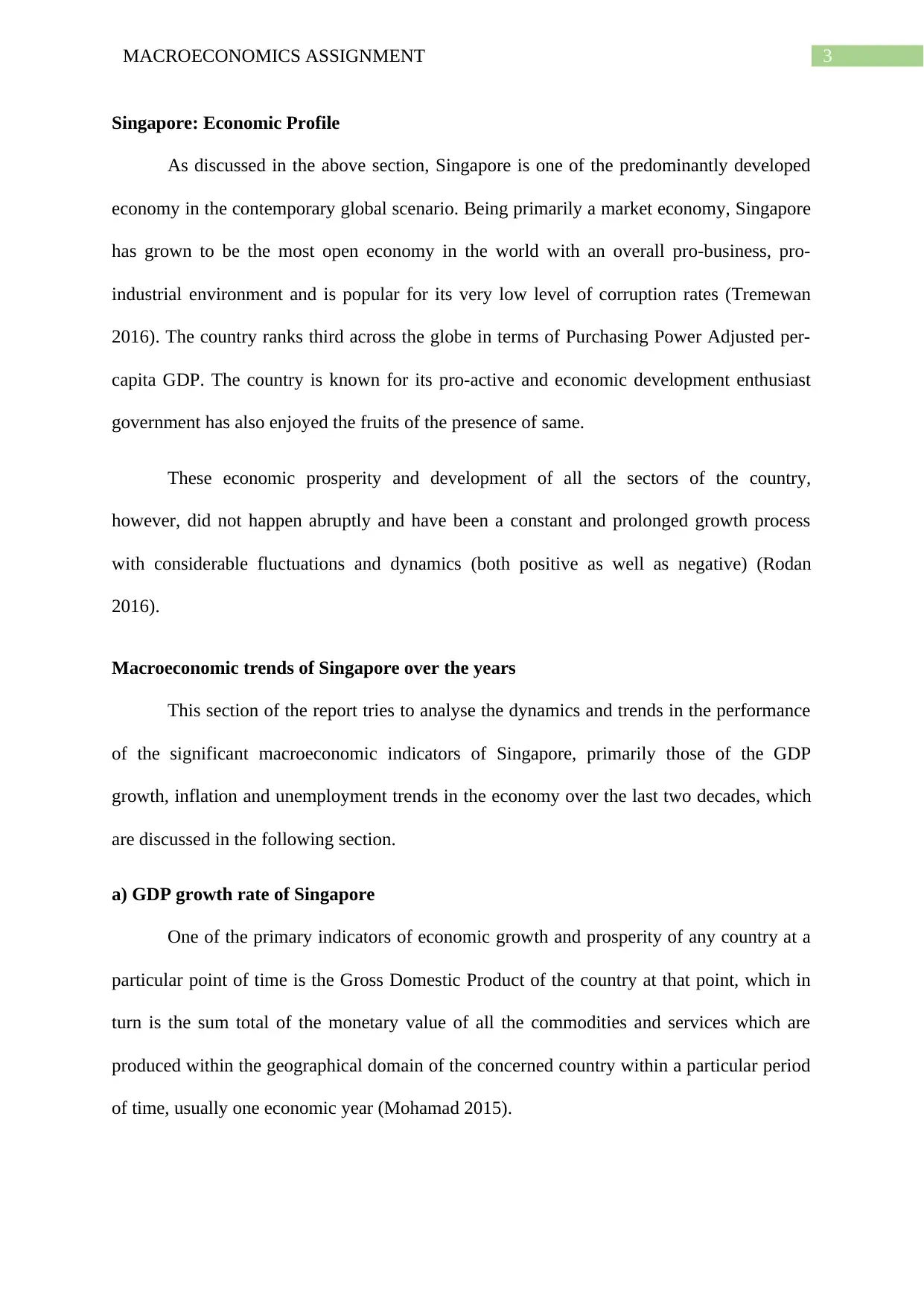
3MACROECONOMICS ASSIGNMENT
Singapore: Economic Profile
As discussed in the above section, Singapore is one of the predominantly developed
economy in the contemporary global scenario. Being primarily a market economy, Singapore
has grown to be the most open economy in the world with an overall pro-business, pro-
industrial environment and is popular for its very low level of corruption rates (Tremewan
2016). The country ranks third across the globe in terms of Purchasing Power Adjusted per-
capita GDP. The country is known for its pro-active and economic development enthusiast
government has also enjoyed the fruits of the presence of same.
These economic prosperity and development of all the sectors of the country,
however, did not happen abruptly and have been a constant and prolonged growth process
with considerable fluctuations and dynamics (both positive as well as negative) (Rodan
2016).
Macroeconomic trends of Singapore over the years
This section of the report tries to analyse the dynamics and trends in the performance
of the significant macroeconomic indicators of Singapore, primarily those of the GDP
growth, inflation and unemployment trends in the economy over the last two decades, which
are discussed in the following section.
a) GDP growth rate of Singapore
One of the primary indicators of economic growth and prosperity of any country at a
particular point of time is the Gross Domestic Product of the country at that point, which in
turn is the sum total of the monetary value of all the commodities and services which are
produced within the geographical domain of the concerned country within a particular period
of time, usually one economic year (Mohamad 2015).
Singapore: Economic Profile
As discussed in the above section, Singapore is one of the predominantly developed
economy in the contemporary global scenario. Being primarily a market economy, Singapore
has grown to be the most open economy in the world with an overall pro-business, pro-
industrial environment and is popular for its very low level of corruption rates (Tremewan
2016). The country ranks third across the globe in terms of Purchasing Power Adjusted per-
capita GDP. The country is known for its pro-active and economic development enthusiast
government has also enjoyed the fruits of the presence of same.
These economic prosperity and development of all the sectors of the country,
however, did not happen abruptly and have been a constant and prolonged growth process
with considerable fluctuations and dynamics (both positive as well as negative) (Rodan
2016).
Macroeconomic trends of Singapore over the years
This section of the report tries to analyse the dynamics and trends in the performance
of the significant macroeconomic indicators of Singapore, primarily those of the GDP
growth, inflation and unemployment trends in the economy over the last two decades, which
are discussed in the following section.
a) GDP growth rate of Singapore
One of the primary indicators of economic growth and prosperity of any country at a
particular point of time is the Gross Domestic Product of the country at that point, which in
turn is the sum total of the monetary value of all the commodities and services which are
produced within the geographical domain of the concerned country within a particular period
of time, usually one economic year (Mohamad 2015).
Paraphrase This Document
Need a fresh take? Get an instant paraphrase of this document with our AI Paraphraser
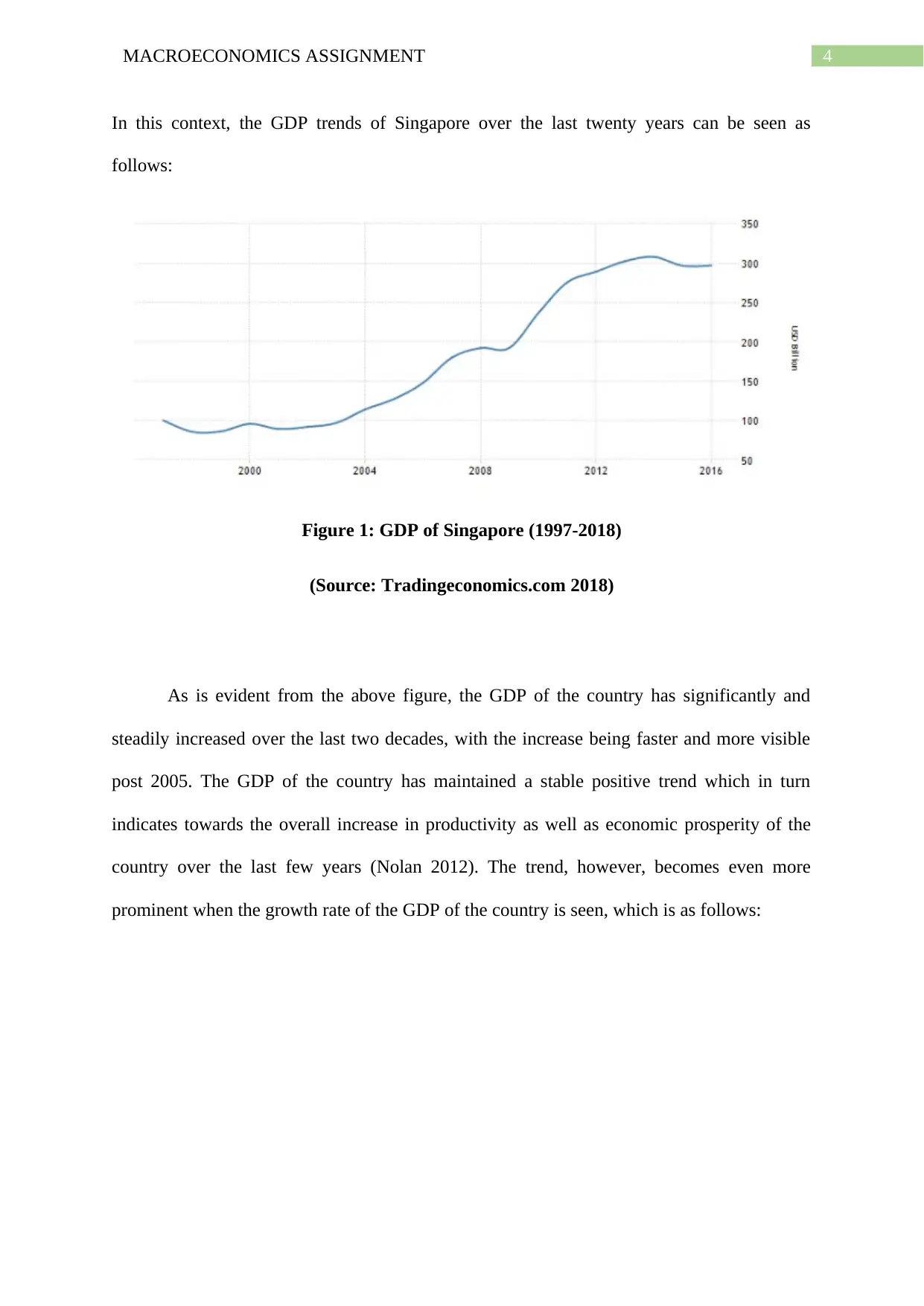
4MACROECONOMICS ASSIGNMENT
In this context, the GDP trends of Singapore over the last twenty years can be seen as
follows:
Figure 1: GDP of Singapore (1997-2018)
(Source: Tradingeconomics.com 2018)
As is evident from the above figure, the GDP of the country has significantly and
steadily increased over the last two decades, with the increase being faster and more visible
post 2005. The GDP of the country has maintained a stable positive trend which in turn
indicates towards the overall increase in productivity as well as economic prosperity of the
country over the last few years (Nolan 2012). The trend, however, becomes even more
prominent when the growth rate of the GDP of the country is seen, which is as follows:
In this context, the GDP trends of Singapore over the last twenty years can be seen as
follows:
Figure 1: GDP of Singapore (1997-2018)
(Source: Tradingeconomics.com 2018)
As is evident from the above figure, the GDP of the country has significantly and
steadily increased over the last two decades, with the increase being faster and more visible
post 2005. The GDP of the country has maintained a stable positive trend which in turn
indicates towards the overall increase in productivity as well as economic prosperity of the
country over the last few years (Nolan 2012). The trend, however, becomes even more
prominent when the growth rate of the GDP of the country is seen, which is as follows:
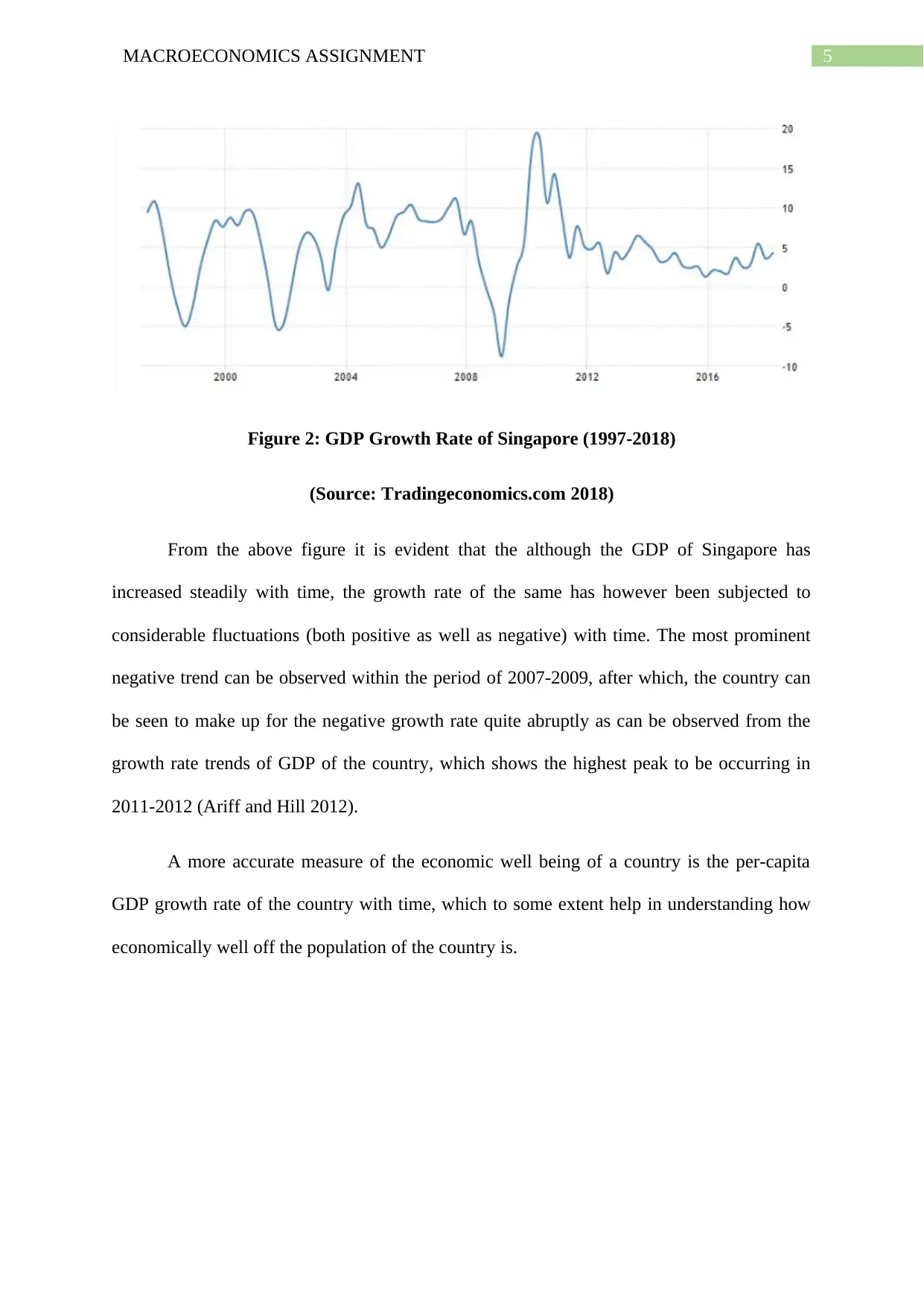
5MACROECONOMICS ASSIGNMENT
Figure 2: GDP Growth Rate of Singapore (1997-2018)
(Source: Tradingeconomics.com 2018)
From the above figure it is evident that the although the GDP of Singapore has
increased steadily with time, the growth rate of the same has however been subjected to
considerable fluctuations (both positive as well as negative) with time. The most prominent
negative trend can be observed within the period of 2007-2009, after which, the country can
be seen to make up for the negative growth rate quite abruptly as can be observed from the
growth rate trends of GDP of the country, which shows the highest peak to be occurring in
2011-2012 (Ariff and Hill 2012).
A more accurate measure of the economic well being of a country is the per-capita
GDP growth rate of the country with time, which to some extent help in understanding how
economically well off the population of the country is.
Figure 2: GDP Growth Rate of Singapore (1997-2018)
(Source: Tradingeconomics.com 2018)
From the above figure it is evident that the although the GDP of Singapore has
increased steadily with time, the growth rate of the same has however been subjected to
considerable fluctuations (both positive as well as negative) with time. The most prominent
negative trend can be observed within the period of 2007-2009, after which, the country can
be seen to make up for the negative growth rate quite abruptly as can be observed from the
growth rate trends of GDP of the country, which shows the highest peak to be occurring in
2011-2012 (Ariff and Hill 2012).
A more accurate measure of the economic well being of a country is the per-capita
GDP growth rate of the country with time, which to some extent help in understanding how
economically well off the population of the country is.
⊘ This is a preview!⊘
Do you want full access?
Subscribe today to unlock all pages.

Trusted by 1+ million students worldwide
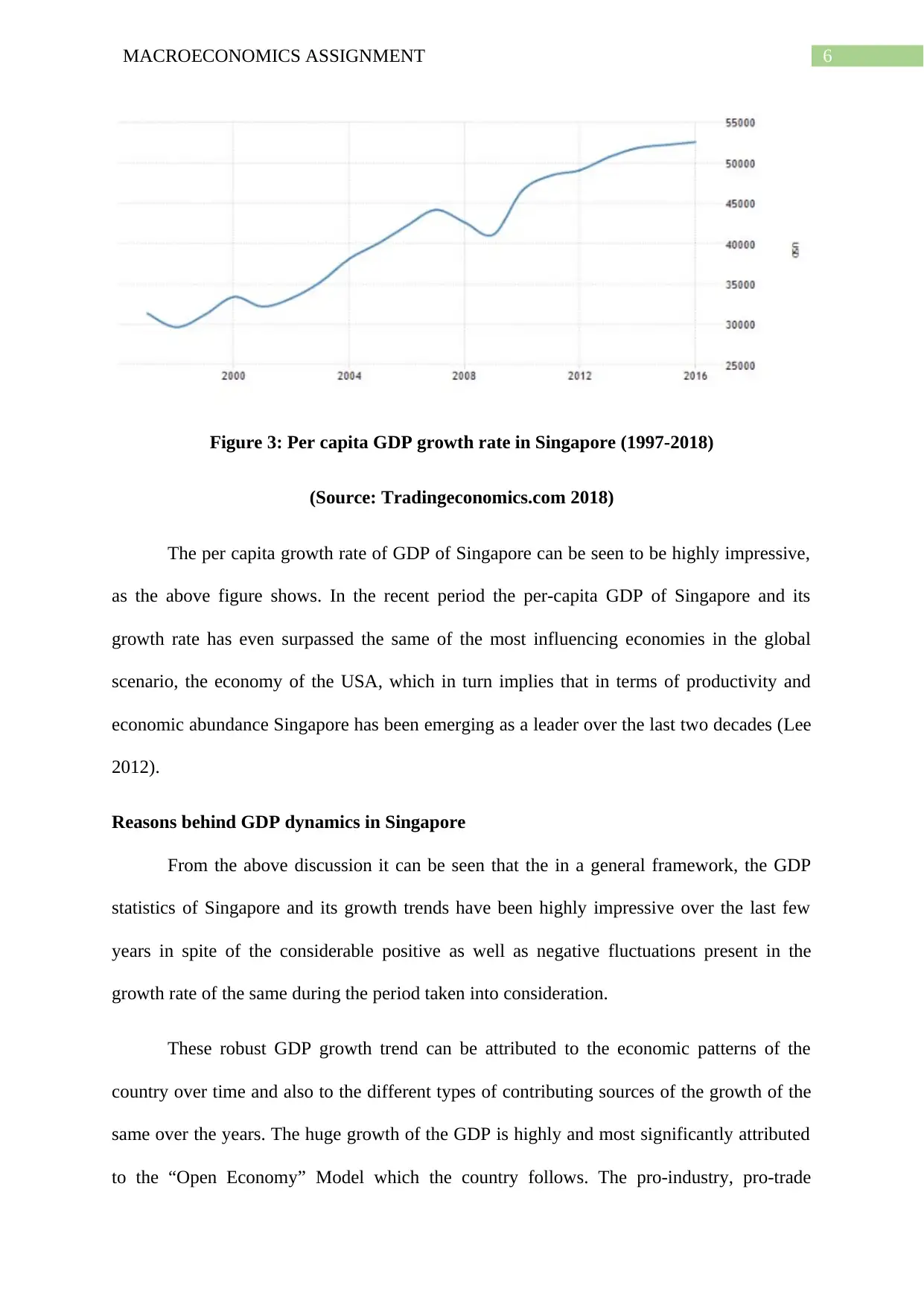
6MACROECONOMICS ASSIGNMENT
Figure 3: Per capita GDP growth rate in Singapore (1997-2018)
(Source: Tradingeconomics.com 2018)
The per capita growth rate of GDP of Singapore can be seen to be highly impressive,
as the above figure shows. In the recent period the per-capita GDP of Singapore and its
growth rate has even surpassed the same of the most influencing economies in the global
scenario, the economy of the USA, which in turn implies that in terms of productivity and
economic abundance Singapore has been emerging as a leader over the last two decades (Lee
2012).
Reasons behind GDP dynamics in Singapore
From the above discussion it can be seen that the in a general framework, the GDP
statistics of Singapore and its growth trends have been highly impressive over the last few
years in spite of the considerable positive as well as negative fluctuations present in the
growth rate of the same during the period taken into consideration.
These robust GDP growth trend can be attributed to the economic patterns of the
country over time and also to the different types of contributing sources of the growth of the
same over the years. The huge growth of the GDP is highly and most significantly attributed
to the “Open Economy” Model which the country follows. The pro-industry, pro-trade
Figure 3: Per capita GDP growth rate in Singapore (1997-2018)
(Source: Tradingeconomics.com 2018)
The per capita growth rate of GDP of Singapore can be seen to be highly impressive,
as the above figure shows. In the recent period the per-capita GDP of Singapore and its
growth rate has even surpassed the same of the most influencing economies in the global
scenario, the economy of the USA, which in turn implies that in terms of productivity and
economic abundance Singapore has been emerging as a leader over the last two decades (Lee
2012).
Reasons behind GDP dynamics in Singapore
From the above discussion it can be seen that the in a general framework, the GDP
statistics of Singapore and its growth trends have been highly impressive over the last few
years in spite of the considerable positive as well as negative fluctuations present in the
growth rate of the same during the period taken into consideration.
These robust GDP growth trend can be attributed to the economic patterns of the
country over time and also to the different types of contributing sources of the growth of the
same over the years. The huge growth of the GDP is highly and most significantly attributed
to the “Open Economy” Model which the country follows. The pro-industry, pro-trade
Paraphrase This Document
Need a fresh take? Get an instant paraphrase of this document with our AI Paraphraser
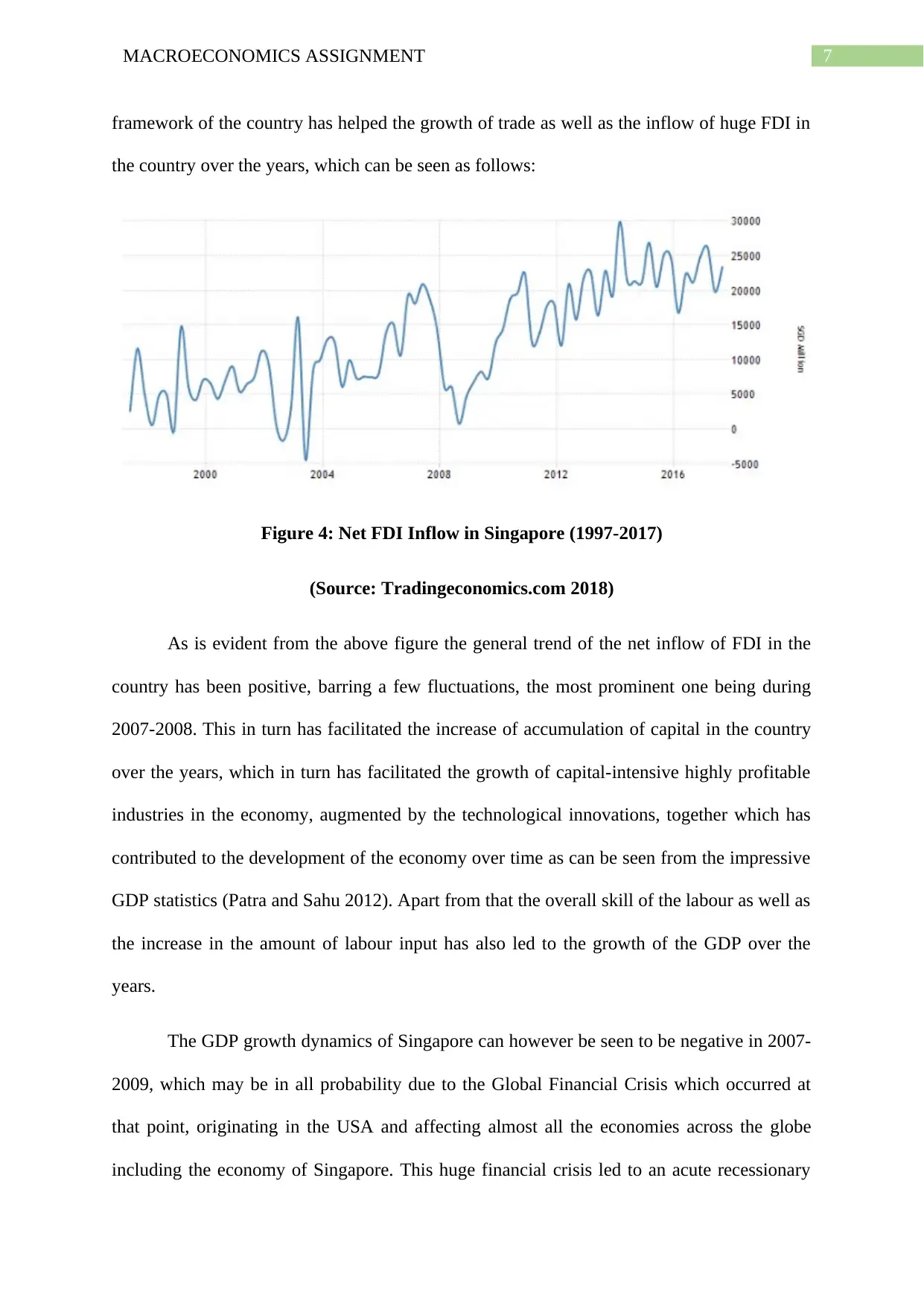
7MACROECONOMICS ASSIGNMENT
framework of the country has helped the growth of trade as well as the inflow of huge FDI in
the country over the years, which can be seen as follows:
Figure 4: Net FDI Inflow in Singapore (1997-2017)
(Source: Tradingeconomics.com 2018)
As is evident from the above figure the general trend of the net inflow of FDI in the
country has been positive, barring a few fluctuations, the most prominent one being during
2007-2008. This in turn has facilitated the increase of accumulation of capital in the country
over the years, which in turn has facilitated the growth of capital-intensive highly profitable
industries in the economy, augmented by the technological innovations, together which has
contributed to the development of the economy over time as can be seen from the impressive
GDP statistics (Patra and Sahu 2012). Apart from that the overall skill of the labour as well as
the increase in the amount of labour input has also led to the growth of the GDP over the
years.
The GDP growth dynamics of Singapore can however be seen to be negative in 2007-
2009, which may be in all probability due to the Global Financial Crisis which occurred at
that point, originating in the USA and affecting almost all the economies across the globe
including the economy of Singapore. This huge financial crisis led to an acute recessionary
framework of the country has helped the growth of trade as well as the inflow of huge FDI in
the country over the years, which can be seen as follows:
Figure 4: Net FDI Inflow in Singapore (1997-2017)
(Source: Tradingeconomics.com 2018)
As is evident from the above figure the general trend of the net inflow of FDI in the
country has been positive, barring a few fluctuations, the most prominent one being during
2007-2008. This in turn has facilitated the increase of accumulation of capital in the country
over the years, which in turn has facilitated the growth of capital-intensive highly profitable
industries in the economy, augmented by the technological innovations, together which has
contributed to the development of the economy over time as can be seen from the impressive
GDP statistics (Patra and Sahu 2012). Apart from that the overall skill of the labour as well as
the increase in the amount of labour input has also led to the growth of the GDP over the
years.
The GDP growth dynamics of Singapore can however be seen to be negative in 2007-
2009, which may be in all probability due to the Global Financial Crisis which occurred at
that point, originating in the USA and affecting almost all the economies across the globe
including the economy of Singapore. This huge financial crisis led to an acute recessionary
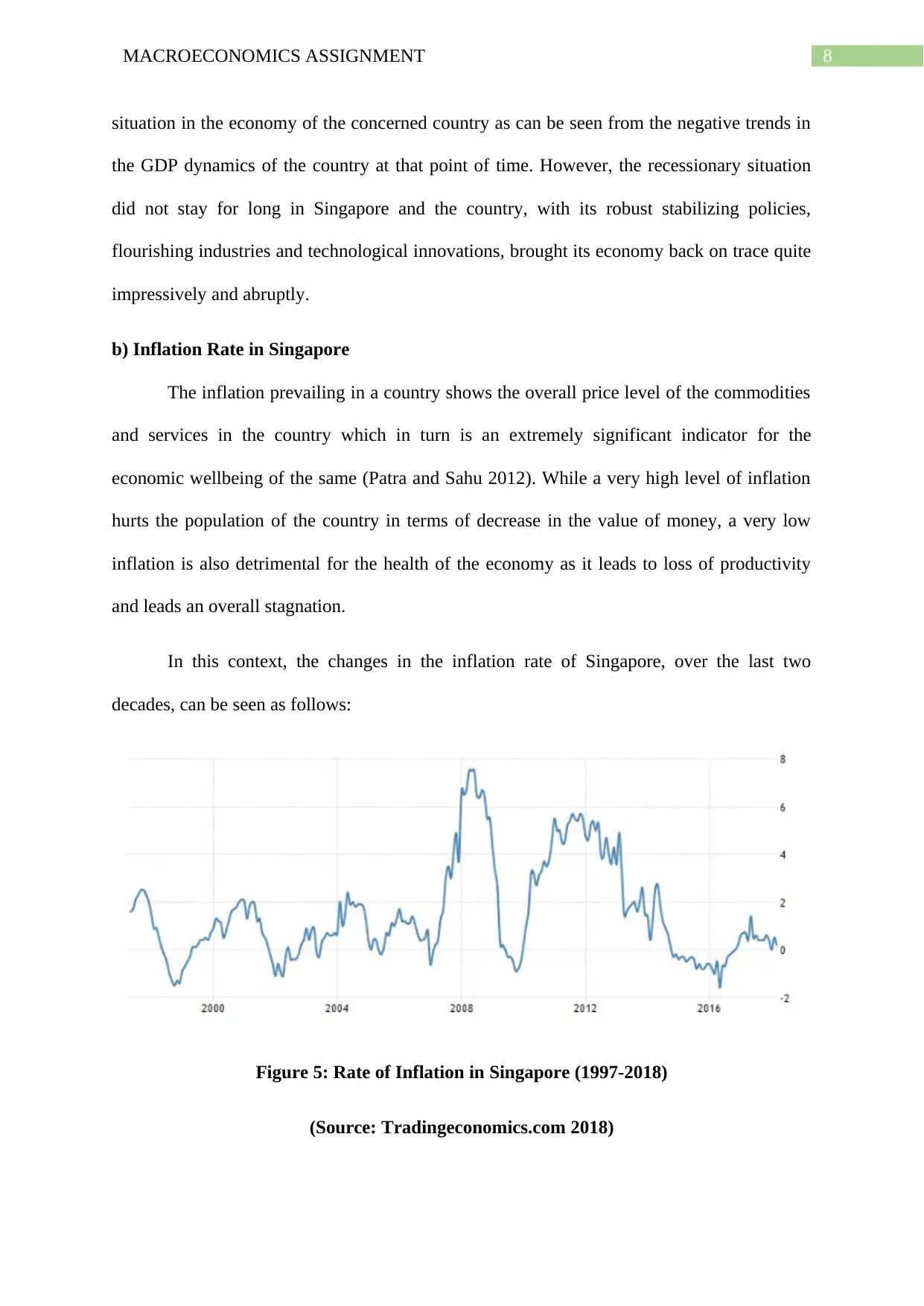
8MACROECONOMICS ASSIGNMENT
situation in the economy of the concerned country as can be seen from the negative trends in
the GDP dynamics of the country at that point of time. However, the recessionary situation
did not stay for long in Singapore and the country, with its robust stabilizing policies,
flourishing industries and technological innovations, brought its economy back on trace quite
impressively and abruptly.
b) Inflation Rate in Singapore
The inflation prevailing in a country shows the overall price level of the commodities
and services in the country which in turn is an extremely significant indicator for the
economic wellbeing of the same (Patra and Sahu 2012). While a very high level of inflation
hurts the population of the country in terms of decrease in the value of money, a very low
inflation is also detrimental for the health of the economy as it leads to loss of productivity
and leads an overall stagnation.
In this context, the changes in the inflation rate of Singapore, over the last two
decades, can be seen as follows:
Figure 5: Rate of Inflation in Singapore (1997-2018)
(Source: Tradingeconomics.com 2018)
situation in the economy of the concerned country as can be seen from the negative trends in
the GDP dynamics of the country at that point of time. However, the recessionary situation
did not stay for long in Singapore and the country, with its robust stabilizing policies,
flourishing industries and technological innovations, brought its economy back on trace quite
impressively and abruptly.
b) Inflation Rate in Singapore
The inflation prevailing in a country shows the overall price level of the commodities
and services in the country which in turn is an extremely significant indicator for the
economic wellbeing of the same (Patra and Sahu 2012). While a very high level of inflation
hurts the population of the country in terms of decrease in the value of money, a very low
inflation is also detrimental for the health of the economy as it leads to loss of productivity
and leads an overall stagnation.
In this context, the changes in the inflation rate of Singapore, over the last two
decades, can be seen as follows:
Figure 5: Rate of Inflation in Singapore (1997-2018)
(Source: Tradingeconomics.com 2018)
⊘ This is a preview!⊘
Do you want full access?
Subscribe today to unlock all pages.

Trusted by 1+ million students worldwide
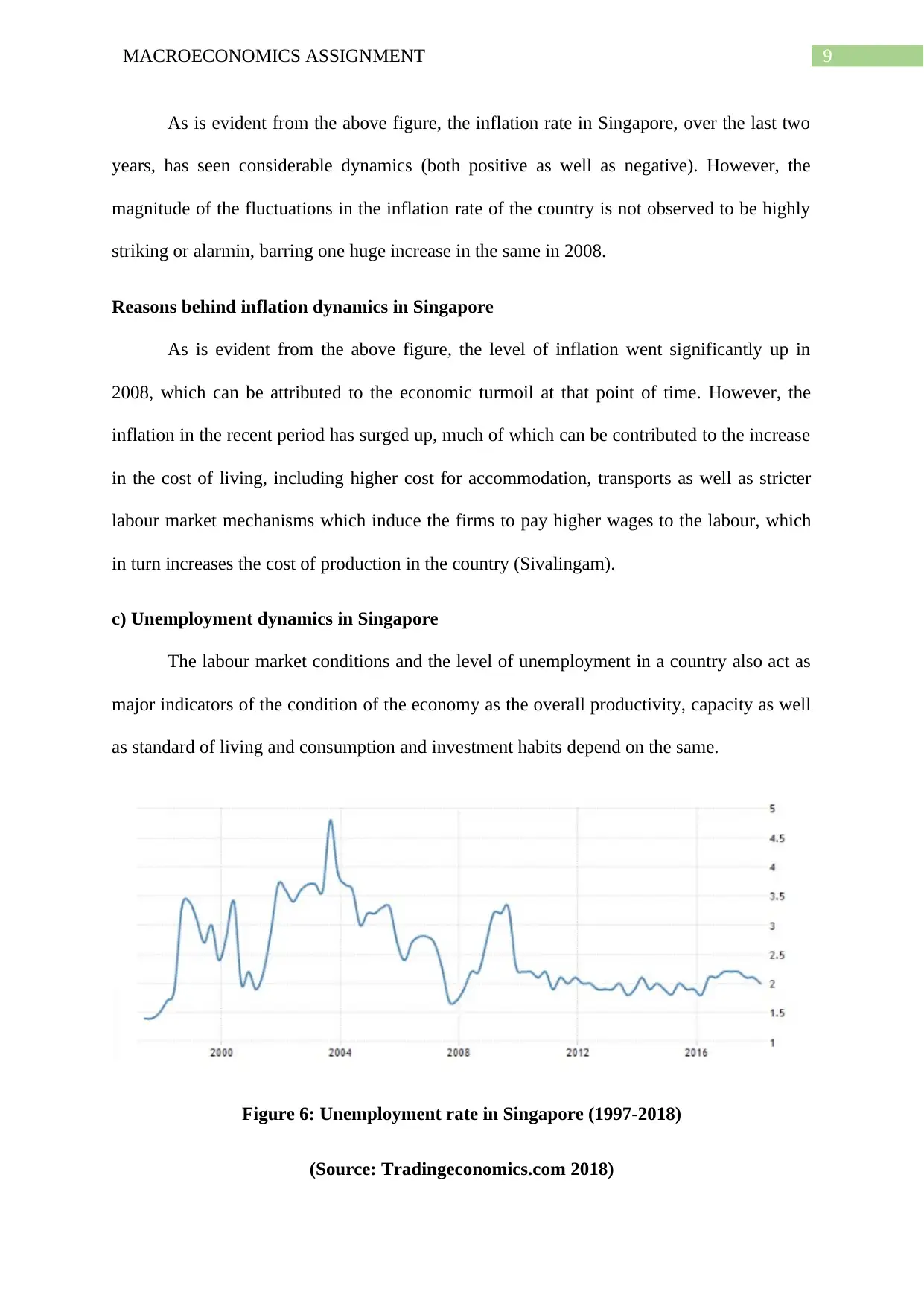
9MACROECONOMICS ASSIGNMENT
As is evident from the above figure, the inflation rate in Singapore, over the last two
years, has seen considerable dynamics (both positive as well as negative). However, the
magnitude of the fluctuations in the inflation rate of the country is not observed to be highly
striking or alarmin, barring one huge increase in the same in 2008.
Reasons behind inflation dynamics in Singapore
As is evident from the above figure, the level of inflation went significantly up in
2008, which can be attributed to the economic turmoil at that point of time. However, the
inflation in the recent period has surged up, much of which can be contributed to the increase
in the cost of living, including higher cost for accommodation, transports as well as stricter
labour market mechanisms which induce the firms to pay higher wages to the labour, which
in turn increases the cost of production in the country (Sivalingam).
c) Unemployment dynamics in Singapore
The labour market conditions and the level of unemployment in a country also act as
major indicators of the condition of the economy as the overall productivity, capacity as well
as standard of living and consumption and investment habits depend on the same.
Figure 6: Unemployment rate in Singapore (1997-2018)
(Source: Tradingeconomics.com 2018)
As is evident from the above figure, the inflation rate in Singapore, over the last two
years, has seen considerable dynamics (both positive as well as negative). However, the
magnitude of the fluctuations in the inflation rate of the country is not observed to be highly
striking or alarmin, barring one huge increase in the same in 2008.
Reasons behind inflation dynamics in Singapore
As is evident from the above figure, the level of inflation went significantly up in
2008, which can be attributed to the economic turmoil at that point of time. However, the
inflation in the recent period has surged up, much of which can be contributed to the increase
in the cost of living, including higher cost for accommodation, transports as well as stricter
labour market mechanisms which induce the firms to pay higher wages to the labour, which
in turn increases the cost of production in the country (Sivalingam).
c) Unemployment dynamics in Singapore
The labour market conditions and the level of unemployment in a country also act as
major indicators of the condition of the economy as the overall productivity, capacity as well
as standard of living and consumption and investment habits depend on the same.
Figure 6: Unemployment rate in Singapore (1997-2018)
(Source: Tradingeconomics.com 2018)
Paraphrase This Document
Need a fresh take? Get an instant paraphrase of this document with our AI Paraphraser
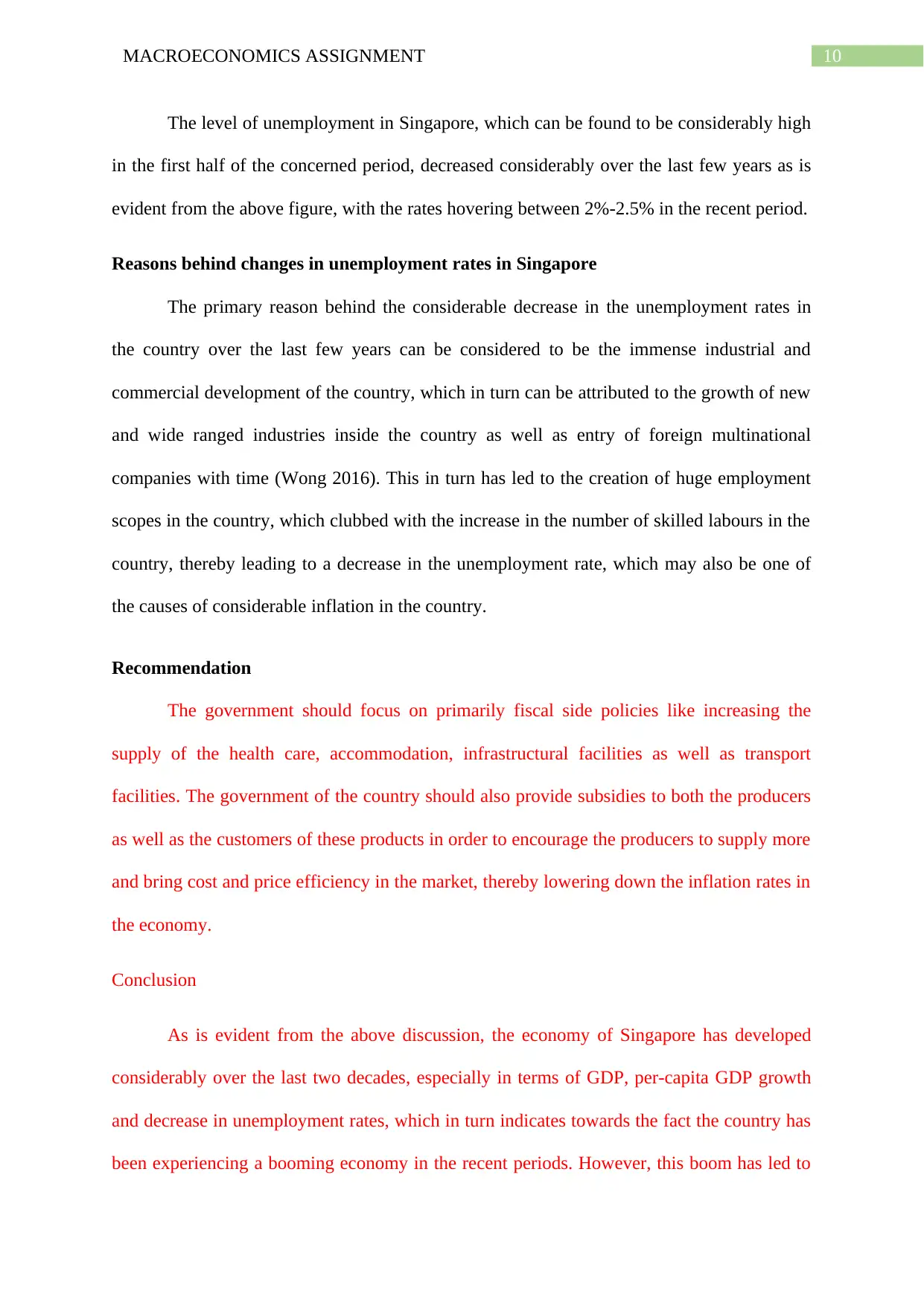
10MACROECONOMICS ASSIGNMENT
The level of unemployment in Singapore, which can be found to be considerably high
in the first half of the concerned period, decreased considerably over the last few years as is
evident from the above figure, with the rates hovering between 2%-2.5% in the recent period.
Reasons behind changes in unemployment rates in Singapore
The primary reason behind the considerable decrease in the unemployment rates in
the country over the last few years can be considered to be the immense industrial and
commercial development of the country, which in turn can be attributed to the growth of new
and wide ranged industries inside the country as well as entry of foreign multinational
companies with time (Wong 2016). This in turn has led to the creation of huge employment
scopes in the country, which clubbed with the increase in the number of skilled labours in the
country, thereby leading to a decrease in the unemployment rate, which may also be one of
the causes of considerable inflation in the country.
Recommendation
The government should focus on primarily fiscal side policies like increasing the
supply of the health care, accommodation, infrastructural facilities as well as transport
facilities. The government of the country should also provide subsidies to both the producers
as well as the customers of these products in order to encourage the producers to supply more
and bring cost and price efficiency in the market, thereby lowering down the inflation rates in
the economy.
Conclusion
As is evident from the above discussion, the economy of Singapore has developed
considerably over the last two decades, especially in terms of GDP, per-capita GDP growth
and decrease in unemployment rates, which in turn indicates towards the fact the country has
been experiencing a booming economy in the recent periods. However, this boom has led to
The level of unemployment in Singapore, which can be found to be considerably high
in the first half of the concerned period, decreased considerably over the last few years as is
evident from the above figure, with the rates hovering between 2%-2.5% in the recent period.
Reasons behind changes in unemployment rates in Singapore
The primary reason behind the considerable decrease in the unemployment rates in
the country over the last few years can be considered to be the immense industrial and
commercial development of the country, which in turn can be attributed to the growth of new
and wide ranged industries inside the country as well as entry of foreign multinational
companies with time (Wong 2016). This in turn has led to the creation of huge employment
scopes in the country, which clubbed with the increase in the number of skilled labours in the
country, thereby leading to a decrease in the unemployment rate, which may also be one of
the causes of considerable inflation in the country.
Recommendation
The government should focus on primarily fiscal side policies like increasing the
supply of the health care, accommodation, infrastructural facilities as well as transport
facilities. The government of the country should also provide subsidies to both the producers
as well as the customers of these products in order to encourage the producers to supply more
and bring cost and price efficiency in the market, thereby lowering down the inflation rates in
the economy.
Conclusion
As is evident from the above discussion, the economy of Singapore has developed
considerably over the last two decades, especially in terms of GDP, per-capita GDP growth
and decrease in unemployment rates, which in turn indicates towards the fact the country has
been experiencing a booming economy in the recent periods. However, this boom has led to
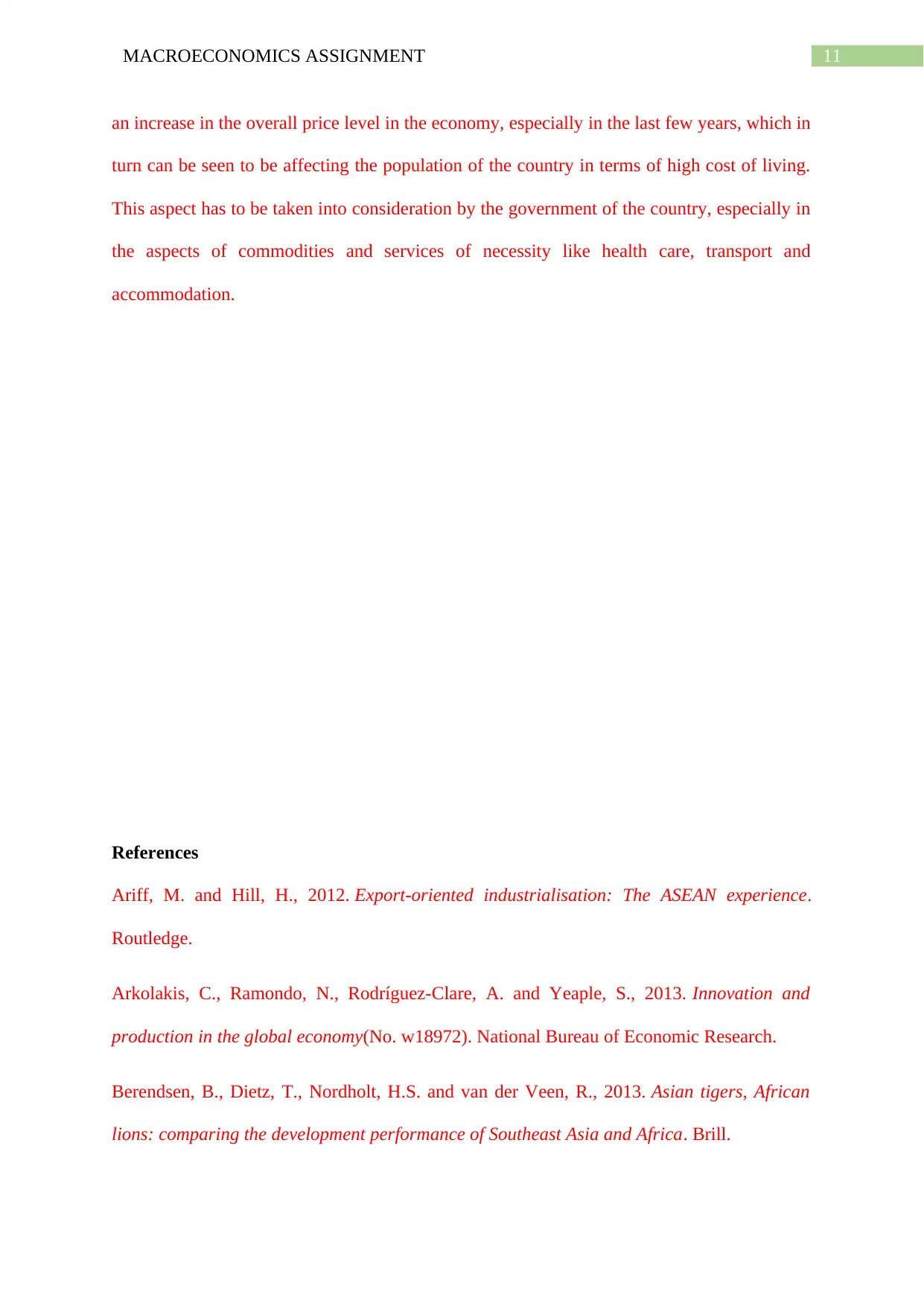
11MACROECONOMICS ASSIGNMENT
an increase in the overall price level in the economy, especially in the last few years, which in
turn can be seen to be affecting the population of the country in terms of high cost of living.
This aspect has to be taken into consideration by the government of the country, especially in
the aspects of commodities and services of necessity like health care, transport and
accommodation.
References
Ariff, M. and Hill, H., 2012. Export-oriented industrialisation: The ASEAN experience.
Routledge.
Arkolakis, C., Ramondo, N., Rodríguez-Clare, A. and Yeaple, S., 2013. Innovation and
production in the global economy(No. w18972). National Bureau of Economic Research.
Berendsen, B., Dietz, T., Nordholt, H.S. and van der Veen, R., 2013. Asian tigers, African
lions: comparing the development performance of Southeast Asia and Africa. Brill.
an increase in the overall price level in the economy, especially in the last few years, which in
turn can be seen to be affecting the population of the country in terms of high cost of living.
This aspect has to be taken into consideration by the government of the country, especially in
the aspects of commodities and services of necessity like health care, transport and
accommodation.
References
Ariff, M. and Hill, H., 2012. Export-oriented industrialisation: The ASEAN experience.
Routledge.
Arkolakis, C., Ramondo, N., Rodríguez-Clare, A. and Yeaple, S., 2013. Innovation and
production in the global economy(No. w18972). National Bureau of Economic Research.
Berendsen, B., Dietz, T., Nordholt, H.S. and van der Veen, R., 2013. Asian tigers, African
lions: comparing the development performance of Southeast Asia and Africa. Brill.
⊘ This is a preview!⊘
Do you want full access?
Subscribe today to unlock all pages.

Trusted by 1+ million students worldwide
1 out of 14
Related Documents
Your All-in-One AI-Powered Toolkit for Academic Success.
+13062052269
info@desklib.com
Available 24*7 on WhatsApp / Email
![[object Object]](/_next/static/media/star-bottom.7253800d.svg)
Unlock your academic potential
Copyright © 2020–2025 A2Z Services. All Rights Reserved. Developed and managed by ZUCOL.




